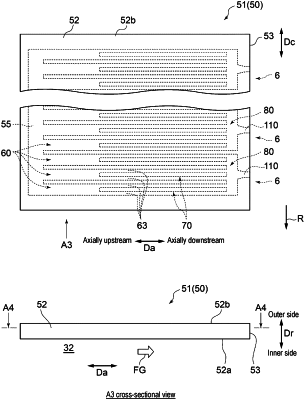| CPC F01D 9/04 (2013.01) [F01D 25/12 (2013.01); B33Y 80/00 (2014.12); F05D 2230/10 (2013.01); F05D 2230/31 (2013.01); F05D 2250/37 (2013.01); F05D 2260/232 (2013.01); F05D 2300/516 (2013.01)] | 17 Claims |

|
1. A high-temperature component which is used for a turbomachinery and needs to be cooled by a cooling medium, the component comprising:
a plurality of cooling passages through which the cooling medium can flow;
a header connected to respective downstream ends of the plurality of cooling passages; and
one or more outlet passages for discharging the cooling medium flowing into the header to outside of the header,
wherein the one or more outlet passages are less in number than the plurality of cooling passages,
wherein respective minimum flow passage cross-sectional areas of the one or more outlet passages are not less than respective flow passage cross-sectional areas of the plurality of cooling passages in a connection between the header and the cooling passages,
wherein a sum of the respective minimum flow passage cross-sectional areas of the one or more outlet passages is less than a sum of the respective flow passage cross-sectional areas of the plurality of cooling passages in the connection between the header and the cooling passages,
wherein the one or more outlet passages each have an inner wall surface whose center line average roughness Ra is not greater than 10 μm in a region where the flow passage cross-sectional area of the outlet passage is minimum, and
wherein the plurality of cooling passages each have an inner wall surface whose center line average roughness Ra is not less than 10 μm and not greater than 20 μm.
|